Strength training for beginners (with 3 strength training exercises)

Hey strength enthusiast’s! Today I am going to be talking all about strength training for beginners. What is strength training, my favorite strength exercises as well as how to set up your own strength program for best results. If you are a sports athlete who needs to become stronger for your sport. Or you’re a complete novice to the gym who wants to get stronger. This article will help you. In my last article I talked about how to clean bulk to gain muscle mass and strength. Here is the link : https://www.theavgguysnutritionandexerciseguide.org/nutrition/clean-bulk-meal-plan-guide/. A clean bulking diet paired with a strength training program will work in tandem. Combined they help us become stronger and achieve better results compared to just strength training. With all of that being said, it’s time to jump into today’s article all about strength training for beginners. So let’s get into it!
- What is strength training?
- Why you should be strength training.
- How you should be strength training as a beginner.
- My favorite strength training exercises.
What is strength training?
Strength training is when we are required to use a muscular contraction to overcome some sort of resistance. It usually involves loaded movements with weights where we apply progressive overload each week. In other words, adding weight to the barbell or lifting heavier dumbbells. Strength training is not only the use of weights. We can use resistance bands, and our body weight with exercises such as pull-ups, cables, or pulleys. Complete beginners to weight training can initially start by adding more repetitions if their technique is still not solid enough to add weight. Slowing down the movement or performing the exercise with stricter technique are also other ways to apply progressive overload. This is useful when we can’t add weight to a movement.
Isn’t strength training just great?
Strength training is extremely versatile making it possible to incorporate it into a lot of peoples exercise routines. Strength training is distinct to other types of training as we are lifting anything at least 75% of our 1RM. Once we have learned the movements so that our technique is solid we can start to add load to the bar each week. To be considered strength training we must train in the 1-6 rep range and rest between 3-5 minutes.
Why do we rest so long?
You should rest between 3-5 minutes to let phosphocreatine stores in your muscles replenish. Resting for at least 3 minutes allows for greater maintenance of force production and rate of force development. Your exercise movement patterns will also be better maintained with longer rest times. Thus targeting the correct musculature and lifting the greatest amount of weight possible. On the contrary, the rest time cannot be too long either. With the appropriate rest times, we can take advantage of greater neural activation which may allow for increased power production.
Strength is not all about the weight
To become stronger we also need sufficient exercise volume performed over the course of a micro-cycle or week of training. Resting for longer periods will help us complete more sets while largely maintaining our force production. Resting for shorter periods is better suited for muscular hypertrophy. If your interested to read into this, below is a study carried out by Willardson and Jeffrey M PhD. https://journals.lww.com/nsca-scj/fulltext/2008/06000/a_brief_review__how_much_rest_between_sets_.9.aspx
Why you should be strength training.
Improved sports performance
First off if you are a sports athlete strength training can improve your sports performance if the strength movement is specific to your sport and helps you perform at a higher level. But just because you can squat 200kg doesn’t mean it will improve your sports performance for all types of sports. A sport like table tennis is more about skill rather than how much you squat in the gym. Extra muscle mass may be a hindrance to great performance in a sport like tennis. On the other hand, for a sport like rugby, squatting big weights is only going to help. The more force we can produce in the weight room, the better as we can apply this force on the field. As rugby is a hugely physical sport, being stronger than your opposition could tip the scales in your favor.
Power matters for sport
A lot of sports such as rugby, soccer and basketball require you to perform movements dynamically, where you need to accelerate quickly with movements such as punching or jumping. Strength training will give you the foundation to build upon and eventually improve your power production. Power is king in sports. Remember before power comes strength and after power comes speed. We can see this in the strength velocity curve down below. The guys at Prehab explain the difference between strength and power well, the link to the article https://theprehabguys.com/strength-versus-power-what-is-the-difference/
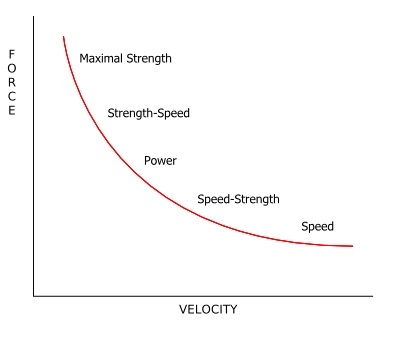
Faster is always better
If your an athlete and you want to become more powerful you firstly build up your maximal strength. Now you can produce more force, which is half of the power equation. The other half being speed. Unlike a lot of sports movements which require quick, rapid movements maximal strength is slow. It’s strength work. It’s the max amount of force we can generate. We are lifting at heavy percentages.
Lay solid foundations
We build up our strength in a strength phase. Later, we include a block of power specific training to complement the strength built up before. After both blocks of training are completed we will be able to lift relatively heavy weights faster. This is a big help in a lot of sports. That means being able to produce more power in the tackle in rugby. Or being able to jump higher in basketball. If the athlete manages to simultaneously maintain their skill level they should see an increase in their on field performance. This is from simply improving their physical capabilities.
Reduced risk of injury
Strength training helps to reduce injury as we are strengthening all of the musculature, ligaments and tendons used throughout a movement. It can also improve range of motion and flexibility if the movements are performed correctly. When barbell squatting we are strengthening the knee, hip and ankle joints and improving their range of motion. When it comes to the field or court our bodies are already accustomed to being brought through these ranges of motion. This also applies to everyday life like bending over to pick up a box. If we are accustomed to a movement and perform it with correct form this means less chance of injury.
Fail to prepare, prepare to fail
If you took an athlete who doesn’t strength train and they enter into their first basketball match against other players who regularly strength train that player is at an increased risk of injury. Due to being weaker compared to the other players. His or her body is not used to the movements being carried out either. Now we have 2 things to worry about. The movements being novel for the player and the other players being physically stronger. Strength training is going to bulletproof his or her body against injury as they can withstand tackles in a sport like rugby for example. Or they can move better while changing direction in soccer as they have no muscular imbalances due to focusing on training both legs one at a time within their strength training program.
No more muscular imbalances
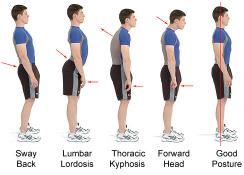
As mentioned prior, strength training helps to reduce muscular imbalances, leading to cleaner movement within everyday life or sports. If we strengthen our hamstrings, core and glutes we are taking stress off of the lower back and reducing lower back injuries which are so common in today’s world. Have you heard of someone complaining about “pulling their back” when lifting up a box? I’m sure you have.
Practice, practice and more practice
Having a muscular imbalance means one muscle is stronger than another. Another muscle is overcompensating for another muscle which isn’t doing it’s job correctly. You can often see with beginners to the gym when they are performing a hip hinge movement like the deadlift they will often use their lower back as the prime mover instead of their glutes, hamstrings and quads. They are using the incorrect muscles because of improper lifting technique. This is only going to lead to injury, and decreased levels of overall strength potential. They are effectively reinforcing poor movement which means they are not using their bodies like they are designed to be used. This is also seen with someone studying at a computer all day. Their chest and front deltoids are overly active due to typing all day. If they don’t pay attention to correct their posture or strengthen their posterior back muscles they are going to develop muscular imbalances. So we need to be aware of how we carry ourselves throughout the day and correct poor postures and movements. Strength training can help rectify these.
Strength training strengthens your bones
Strength training places temporary stress on your bones sending signals to your bone producing cells to build stronger bones to match the demands placed upon them. This is particularly useful for the older population who can see decreases in bone density as they age. Weight training will help keep sending the signal to their bones to maintain their bone density and “keep strong!”.
You can eat more food
Strength training is going to help preserve muscle mass which requires more energy to maintain. We can eat more calories compared to someone with lower levels of muscle mass. Putting on fat is going to be more challenging since we can eat more food which is never a bad thing! Especially for older individuals whose metabolism slows down the older they become. Keeping the habit of strength training could mean you stay leaner which I think a lot of us would like not just beginners to strength training.
Training for strength may boost our moods
Strength training can help boost our mood as when exercising we release feel-good endorphins. This explains why you feel “amazing!” after strength training and you feel like you could do just about anything. Just about..! Strength training is of course going to make us stronger but we can also notice increases in muscle mass. Both of these things can improve our self-esteem.
How you should be strength training as a beginner
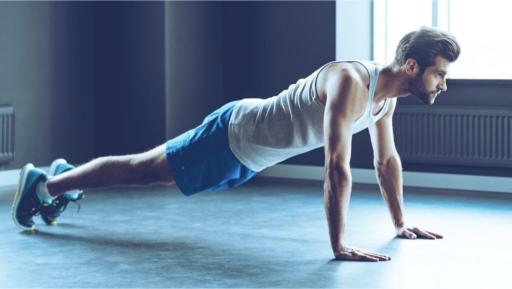
Alright this is important as strength training for a beginner versus a person with a greater number of years under their belt. When you are a beginner the great news is that you are going to see very rapid strength progress as we are applying a new stimulus to the body. If you have never squatted before and you start implementing squats into a strength training program and stay consistent each week. You will see great progress.
Ah to be a beginner again.
You may have heard the term “beginner gains” among gym folk. This describes the rapid increases in strength and muscle beginners make as they are completely new to weight training. Some people are naturally born stronger (i.e the guy that squats 150kg but has never touched a barbell in his life!) than others and they also see the same rapid progress once starting to consistently strength train. These are the people that will go on to lift big numbers. Even if you will never reach the same levels of strength compared to them you can see great progress too. This is your journey. If I was a beginner to strength training this is how I would set up my strength training:
Setting up your own strength training program
Remember with strength training we are going to be training with at least 75% of our 1RM’s and performing exercises in the 1-6 repetition range. If you don’t know your 1RM or are a complete beginner to the gym, testing your 1RM could actually do more harm than good since you would be performing a lift that you have never done before while lifting a very heavy load. Lifting an extremely heavy load like this calls for confidence under the bar. Strength training as a beginner and trying to attempt 1RM’s is just a recipe for injury and another viral YouTube video. Don’t be that person!
Progress is progress
If you are a complete beginner to strength training, look to progress on all of your lifts each week. I mean better technique, keeping the movement relatively slow so we give our bodies a chance to adjust to new ranges of motion and solidify them. Once you’re starting to become accustomed to the new movements, the range of motion and movement is looking solid we can look to make progress with weight. Look to add 2.5kg – 5kg each week. Some of you will probably be able to add more than that in the first few weeks. By all means go for it, once your technique is holding up.
Breathing and bracing
Working on your breathing as a beginner to strength training is going to be new for you. When performing exercises like the barbell squat, bench press and deadlift we want to imagine our torsos like a can of coke. Inside this container we take a big breath filling up our stomachs with air and then bracing our core. This creates a really strong link between our lower and upper body which will improve power production and allows for the maintenance of better technique throughout the movement.
1RM testing
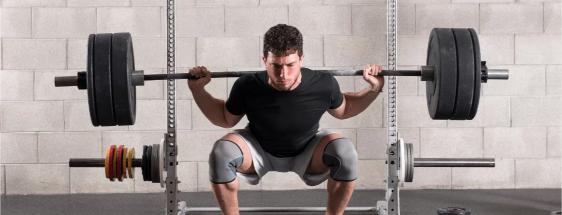
After a few weeks or the first few months of strength training your technique is probably a lot better than when starting out. You have managed to add some weight to your lifts. Here is when you could test your 1RM for a given lift or if you’re not feeling that confident and prefer to play it safe you can use a 1RM calculator in conjunction with performing an exercise like a barbell squat with a sub-maximal load for as many repetitions as you can safely lift the weight. After completing the exercise we input the weight and repetitions achieved in the 1RM calculator and we have our 1RM estimate. Now we can do all kinds of exciting things with this like using it to construct a strength training program using percentages.
Compound exercises are for 1RM testing
When looking to test a 1RM or achieve a number of repetitions with a heavy weight to input into our calculator exercise selection matters. We want to perform compound movements, movements where we are using multiple muscles at the same time. Such as a barbell squat, bench press or deadlift. These are different to isolation movements, such as a lateral raise which strictly targets the side deltoids/shoulders if performed correctly.
Why do we do this?
We only want to test our compound movements as these are the movements where using percentages within a strength training program makes sense. These are the lifts where you will get the most bang for your buck. You will strengthen multiple muscles all with 1 movement, you can lift the most weight and you can make greater progress with weight. With a lateral raise, we only have the side deltoid/ shoulder working. We are not going to see the same progress compared to a barbell squat. With a barbell squat you can make greater progress so using percentages is possible. With a lateral raise because the weight being lifted is so small, there’s really no point in 1RM testing. With the results you can’t set up a percentage based program with a 1RM lateral raise since it’s not a lot of weight. We can’t make big jumps in weight being lifted each week. If you are an athlete an isolation movement like the lateral raise is not going to improve your performance unless that sport is who can lateral raise the most weight strictly right?
Use percentages within your program
Using percentages when strength training are very useful as we now have a plan to follow to get stronger. It’s not random. For example you would lift a certain percentage of a lift during the first week and the next week you will lift a higher percentage of your 1RM. Once you have completed the second week, you have just applied progressive overload. You have lifted a heavier weight. You have gotten stronger. Now when you train in the next mesocycle (i.e weeks of continuous training before taking a deload/rest) you will be able to look back on your numbers and accurately say “well last mesocycle I lifted 100kg for 80% but this mesocycle I lifted 110kg for 80%.” You have just made strength training progress!
It’s a mind thing.
If you did not use percentages well for some of us we may be a bit timid with adding weight to the bar. We are capable of lifting more than what our minds actually believe or how we feel on that particular day. Percentages give us a target to aim for so we KNOW we are making progress.
Watch this!
You also have people on the other end of the spectrum that want to lift anything and everything they see. This is common to see with beginners who try to lift a weight that is too heavy for them to lift safely , but their ego won’t let them lower the weight. ” 4 weeks into strength training ? 110kg bench press? No problem bro!” This can lead to serious injury. In reality their bodies are just not ready to handle those loads. Percentages ensure we still see progress but we leave out the injury part, which I don’t think any beginner to the gym wants!
What does using percentages in a strength training program look like?
Now as a beginner you know the benefits of using percentages, how would you implement them into a strength training program? First off find your 1RM or estimated 1RM. Then design yourself a strength training program where you are going to use percentages for your main compound lifts. Such as the barbell squat, bench and deadlift. We want to start week 1 with a percentage which is lower compared to week 2, so we lay the foundation so to speak to see progress in week 2. We also don’t want to jump the gun and train all out with extremely taxing loads like 90% and above. This is fatiguing on the nervous system. We cannot hope to train with the same amount of volume and duration compared to starting our program with a lower intensity. Instead in week 2 we lift with a slightly higher percentage compared to week 1 and so on.
Week to week percentage progressions within a mesocycle:
Week 1: Barbell squat @86% 4×6
Week 2: Barbell squat @ 88% 4×5
Week 3: Barbell squat @ 91% 4×4
Week 4: Barbell squat @ 94% 4×3
Week 5: Deload/Rest week.
We can see above that we have started with a percentage which is high enough, allowing us to train for strength. But not so high we don’t shock our nervous system, experience too much fatigue, and have no room left to progress. We have increased the percentage and weight each week to drive progressive overload. The repetitions’ are simultaneously decreasing to accommodate the higher percentages and fatigue that comes with it. We have kept the number of sets the same as we want to have enough volume to drive muscular hypertrophy or gain more muscle which will indirectly help us get stronger.
Strength is a skill
Performing multiple exercise sets help to improve our strength endurance and we get more practice with the movement. This means we are more skilled at performing the lift. If we are more skillful we will lift better/more weight just like Micheal Jordan used to throw 100’s of shots to perfect his shot for basketball. Being skilled at lifts like the squat, bench press and deadlift is very useful for a sport like powerlifting which is comprised of these 3 lifts. But being able to lift well and safely will also help sports athletes to strengthen the right musculature which they will use in their individual sport and help reduce injuries. For the weekend warrior this means performing everyday movements with the correct technique prehabing against injury. Down below is a table you can use to design your own strength training program, taking out the guesswork around percentages.
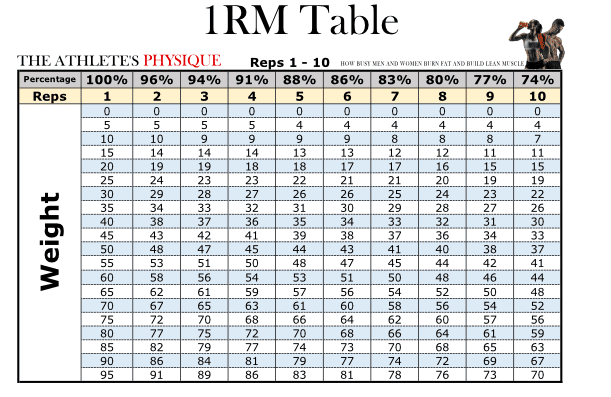
Strength train at least 3 days a week
Training frequency and volume is going to be important if we want to make continued progress with our strength training. You see we can strength train at high intensities and lift heavy weight but we are merely showing off our strength abilities and not improving on them. Not good if your a sports athlete and the other players are getting stronger but your staying the same. Remember in order to see progress we need to apply progressive overload. This also applies for volume. We want to train at the highest volumes we can recover from while simultaneously lifting at a higher intensity each week to elicit the best adaptions to training. This is also called our MRV or maximal recoverable volume.
3 is the magic number
I say train at least 3 days a week because 3 days are about enough days to fit in sufficient volume to reach our MRV if we are new to training. If you are training below that, you won’t make as much progress compared to 3 days. If you are fine with that that’s alright. Some beginners to strength training may get really sore after strength training during their first few weeks of training. They can’t handle a lot of volume since they are not accustomed to it. That’s ok! Do what you can and before you know it you will be able to tolerate higher volumes. That’s when you can increase your volume.
Finding your MRV
You can find your MRV by starting your training with a certain number of sets (be conservative,i.e 4-6 sets for quads) and try to increase the number of sets performed each week. After a while you will notice that your performance may start to drop or you can’t lift more weight. This could be a sign you are over fatigued and should take a deload or rest to recover and come back fresh for the next mesocycle or weeks of strength training. Now you know your MRV and can train at it or close to it to get the best results. In other words get stronger!
Quality over quantity
Training at least 3 days per week also allows us to perform our lifts at least more than once per week. This will help us learn the movements patterns faster, reinforcing great technique which will lead to more weight being lifted and a reduced risk of injury. We also get more quality work in compared to only training a muscle group 1 day per week. We are fresher performing a few quality sets compared to ALL of our sets in 1 day. Your not going to be able to target the muscles as best as you could and you increase the risk for injuries the more fatigued you become the deeper into a training session. An example of setting up a week of training could look like this:
Training frequency during a micro-cycle/week of training:
Week 1:
Day 1:
Barbell squat @88% 4×5
Day 2:
Barbell bench press @86% 4×6
Rest day
Day 3:
Barbell squat @86% 3×6.
Barbell bench press @88% 3×5
The volume will be individual for each person’s own recovery capabilities. We can clearly see we have split up the volume into 2 separate days and we give each muscle at least 24 hrs to recover before training it a second time. This is going to give us time to recover for the next training session so we continue to make progress. The percentages also vary to allow for some mitigation of fatigue. With smaller muscles like the biceps they recover really quickly but a muscle like the quadriceps will take longer to heal. The same is true for compound exercises like the barbell squat over the bicep curl.
Perform the main compound movements before accessory movements
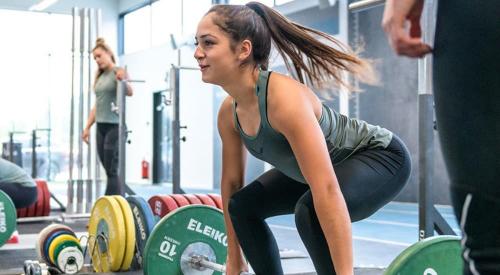
We want to perform the compound movements before the accessory lifts as these are where we are going to predominately build our strength. Do you think you will build strength with a barbell bench press or a lateral raise? Of course the barbell bench press. It involves multiple muscles which all contribute to lift the weight. With an isolation movement like the lateral raise we are only working our lateral deltoid/shoulder. There is not a whole lot of weight to be lifted.
Compound exercises are king
With a compound lift like the barbell squat this works your quadriceps and glutes which are the prime movers. The hamstrings, thighs and erectors are the synergist muscles. Not to mention you need strong stabilizer muscles like the obliques and your pelvic floor to support the weight. That’s a lot of different muscles being worked with 1 movement! As this exercise involves a lot of muscles we can lift more weight. It also means we inflict more damage on the muscles being worked compared to an isolation exercises like the quadricep extension. This means we can do 4 sets of barbell squats but still work the muscles as hard as 6-8 sets of quad extensions. That’s less time in the gym for the same muscle and strength gains.
We like to move it move it!
We are not only training muscles with compound movements we are putting our bodies through movement patterns too. Training the bench press is going to translate to increased performance in a sport such as rugby where you need to have a strong upper body to shrug off tackles.
It’s also important to train the compound exercises first as they are a riskier exercise to perform compared to an accessory exercise. They involve lifting heavier weight and are more complex to perform. With a squat you are loading your ankle and hip joints as well as breathing and bracing to keep an erect upper body. We want to be fresh and not fatigued to perform them with great technique. Afterwards we can move onto our accessory movements which are less taxing to perform.
Accessory exercises for strength
Just like compound movements have their place in a strength program so do accessory exercises. Accessory exercises are lifts that are going to compliment our compound lifts. Unlike with compound movements, accessory exercises allow us to focus on particular parts of a movement such as with a stiff-legged deadlift which places emphasis on the hamstrings and glutes. This is great for someone who has weak glutes and hamstrings and needs to strengthen them to lift a bigger deadlift. Or give them the raw strength which can be built upon to make you accelerate quicker for sports. With accessory exercises we can also target a muscle or limb with greater accuracy which helps us to prevent or fix muscular imbalances which can lead to decreased performance and injury. This could be a Bulgarian split squat which works 1 leg at a time to ensure both of our legs are equally strong.
Accessories help with muscular hypertrophy
Targeting a muscle with greater accuracy is also going to help us with muscular hypertrophy or increasing our muscle size. If we try to perform a movement like the regular bench press to target our triceps this is ineffective as the bench press also works other muscles, namely a prime mover like the chest. The chest may fatigue before the triceps, especially if your triceps are a strong point.. This is not a good thing if our goal is to maximally stimulate the triceps for muscular hypertrophy and make them stronger. In this situation the chest gets maximally simulated but the triceps can still tolerate extra work since they are the stronger muscle.
Specificity matters
A better approach would be to keep barbell bench sets consistent within a strength training program and add in a movement like the close grip bench press to better target the triceps. Now we isolate the triceps to a greater degree and we are not wasting our already limited energy resources on training other muscles that are not the intended target. Remember our big compound movements like the bench press or squat are where we will get the most bang for our buck in terms of strength and size. Accessories we can add in for some extra volume for size gains and to help us better target individual muscles.
Accessories
An example strength training day with accessories included could look like this:
Week 1:
Day 1:
Barbell deadlift 4×5 @88%.
Stiff-legged deadlift 4×8 @80%.
Barbell row 4×8-10.
All of these exercises build on top of each other. We have our deadlift which works a lot of different muscles. The stiff-legged deadlift targets the glutes and hamstrings so we strengthen these muscles for a stronger deadlift. We can also perform a movement like the stiff leg deadlift with higher repetitions which leads to increased muscular hypertrophy. This indirectly helps with strength by adding muscle mass, and improving our leverages. Lastly, we have the barbell row with a higher rep range to target the upper back muscles which contribute to the lockout on the deadlift. A stronger back helps to improve our posture from all of the bench pressing we may be doing. A stronger back means a stronger bench press meaning a stronger handoff in rugby or a more powerful throw in shot putt. We also get some muscular hypertrophy too.
Periodize your strength training with hypertrophy and power blocks
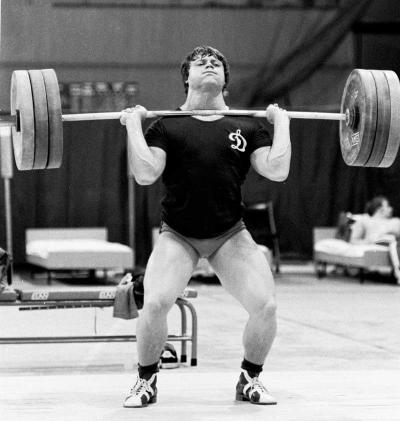
You will notice while strength training, initially you make a lot of progress. You are adding weight quickly and all is going well. Soon you will be able to do just about anything! But this is not how strength training always works. After a while you will start to feel fatigued, the training you used to do no longer leads to new gains. You may lose motivation to go to the gym or maybe your joints and muscles are starting to feel a bit “meh”. This is your body telling you you should give it a rest. Just like we rest between training days which is essential to come back stronger than before we need to do the same after a few weeks of strength training.
No one person is the same
It will be individual for each person. You need to be your own self-monitor. Some people will be able to train for longer and with higher volumes compared to others. Frank trains for 3 weeks and needs a rest on the 4th week while Juan can train for 4 weeks and looks like he can add a 5th! This could be based on lifestyle factors like sleep, nutrition, outside stressors or genetics. No matter your recovery abilities each person will reach a time when they need to rest. This is when you can include a deload or rest week where we perform all exercises with a reduced intensity and volume to let our bodies recover. This could look like this:
Last week of our mesocycle:
Day 1:
Barbell squat @90% (100kg) 4×4
Deload:
Day 1:
Barbell squat @45% (50kg) 2×4
You can see here that we have halved the intensity and volume which is going to allow us to enter the next mesocycle feeling fresh and ready to hit new PR’s.
Include a hypertrophy or power block
As well as taking deloads we can decide to completely switch our training focus and develop other attributes which are going to help us get stronger in the long run. Ironically training for strength all of the time is not going to make you stronger! Our bodies can only get so strong before our progress stall because of fatigue and staleness from strength training for a long time. Or maybe our bodies have adapted to the stimulus and now the strength training we were doing is just not producing new gains for us anymore. Or maybe we have just maxed out on how strong our body can get with our current body weight.
Bigger is sometimes better
This is the perfect time to introduce a hypertrophy or muscle building phase to build new muscle which improves leverages, leading to more strength. With more muscle you have “more potential” to get stronger. After a muscle building phase, we could return to a strength-focused block of training to translate that new muscle into strength. A typical training cycle could look like this:
Meso 1/ Strength focused:
- 4 weeks accumulation/training.
- 1 week deload/rest.
Repeat for 2 more mesocycles.
Meso 1/ hypertrophy focused:
- 4 weeks accumulation/training.
- 1 week deload/rest.
Repeat for 2 more mesocycles.
Meso 1/ Strength focused:
- Repeat with new weights and percentages.
I got the power
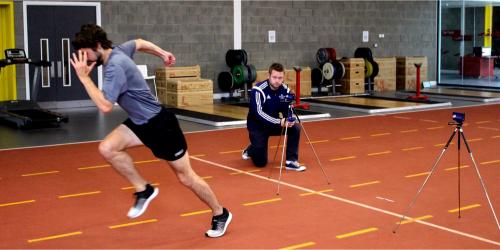
Another block you could add in are power blocks, these are really helpful for sports athletes who will benefit from increased power production. Here we are lifting anywhere from 30-60% of our 1RM and moving it as fast as we can. You could include this block just before commencing a new season so you “hit the ground running” and your ready for the rapid, powerful movements which will occur during the course of your sport. With a power block we are not completely forgetting strength though.We still want to include a strength movement to maintain the strength we have build up.
An example of a typical power day could look like this:
Day 1:
The power movement:
Banded barbell squats @60% 5×4
The strength movement:
Barbell Bulgarian split squats 4×6
My favorite strength training exercises
Now you know some programming basics it’s time to pick the exercises that will lead to best results. We can split exercises into compound, accessories and power movements. I will give you a few examples of compound strength exercises in this article. Feel free to modify or swap them if you prefer an exercise over another or you are carrying an injury. So let’s get into them!
Compound strength exercises
The barbell squat

Some people call this the king of all exercises and you you will see why when squatting! It targets your quadriceps, hamstrings, thighs, erectors and the other trunk muscles to keep your body erect. This exercise should be one of if not the main leg exercises you should be incorporating into your strength training
If strength is your goal, program this exercise at the start of your training day. This is one of the most taxing exercises so give it priority status. We want to lift heavy weights with the barbell squat as we are training strength. Remember this is anything 80% or above. Which is about 6 repetitions or less. We also want to rest for at least 3 minutes between sets. An example of this could be:
4×5 @90%
How to preform it:
The set up:
- Set the pins in the rack at an appropriate height. (this should be so that you can slightly apply force with your quads into the ground and the bar lifts off the rack.
- When unracking the weight, firstly set your shoulders under the bar. The higher up the bar is on your back the more quadriceps you target and the more upright you need to be. The lower the bar on your back the more you involve the glutes, lower back and hamstrings. You will have greater forward lean. Once you have decided where you will place the bar on your back, set your feet about shoulder-width apart. Take a deep breath into your stomach, obliques, and lower back and brace your core hard. Maintain a tight grip on the bar. With your hands closer together you will create a stiffer lifting posture. Play around with this and see what works for you.
The movement:
- Once the weight is unracked, step back 2-3 steps leaving just enough space between the bar and rack so you don’t bump into it on the ascend. We don’t want to step back too far away from the rack either as this wastes energy. Once standing statically take another deep breathe and brace your core.
- While picking a point on the wall a little lower than eye level, break at the hips and knees simultaneously and keep your torso as erect as you possibly can. It can help to keep the descend slow and controlled. Once your hips are at about 90% or just below drive up as forcefully as you can while keeping your technique solid. Reset and repeat until you finish your whole set.
The barbell conventional deadlift
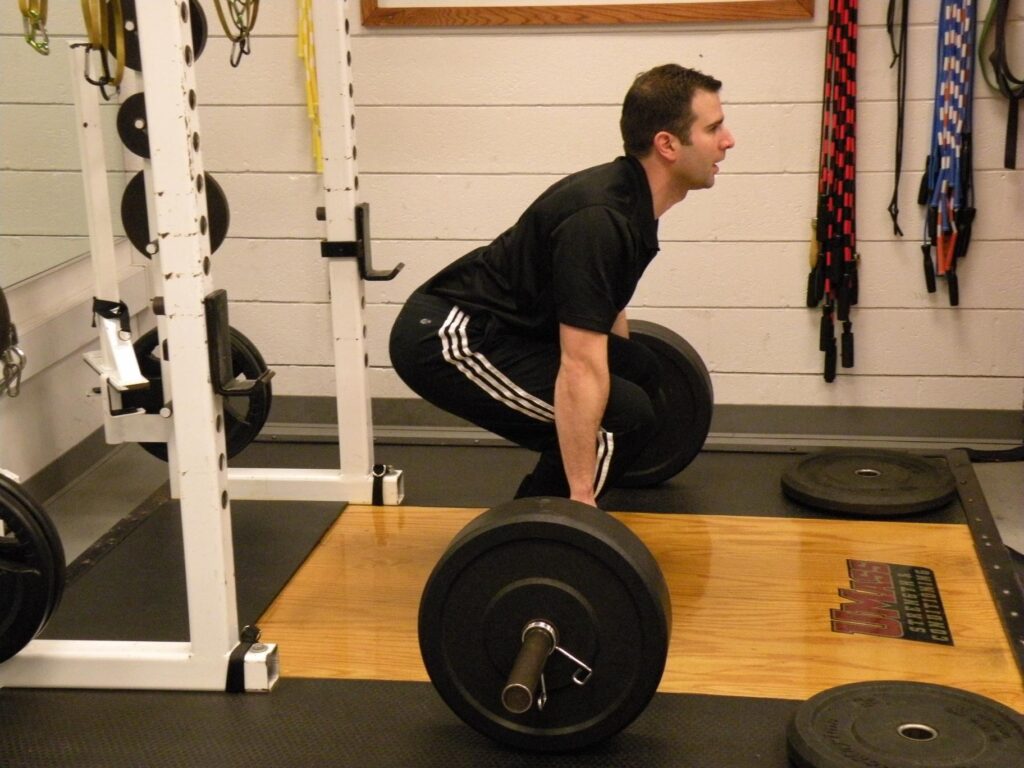
This movement is one of my favorite because it hits pretty much everything! Your quadriceps, glutes, hamstrings, erectors, trapizius muscles, lats, and biceps. This is a great movement to perform for total body strength. It also looks a lot like picking up a box as it’s a hip hinge movement. If you can deadlift 150kg you will pick up a box no problem! I like to program this exercise on its own day or paired with a barbell squat. It’s probably one of the most fatiguing exercises you can preform so you want this as one of the first exercises you do on a training day. Again rest for at least 3 minutes and aim for no more than 6 repetitions within a set. This could look like:
4×4 @91%
How to preform it:
The set up:
- Start with placing your feet about shoulder width apart. You can play around with this to find what feels comfortable for you. Next grip the bar about shoulder width while also maintaining a tight grip on the bar. You can use a mixed grip here which makes it easier to hold onto the bar when lifting very heavy weight. Other grips include the hook grip where you wedge the barbell between your thumb and fingers or double overhand grip.
- Brace your lats to pull the slack out of the bar. Take a deep breath into your stomach and lower back and brace your core hard.
The movement:
- Pick a point on the ground with your eyes which allows you to keep a neutral spine. Usually this is looking at the ground a little ahead of you.
- Push your quadriceps into the ground while pulling with your back muscles and finishing the movement by using your glutes to push your body into an erect standing position. Once standing with the weight, lower the weight under control and repeat. You may need to reset your breath between repetitions and that’s perfectly normal! It’s also normal to have a big red face, so don’t worry about that either!
The barbell bench press
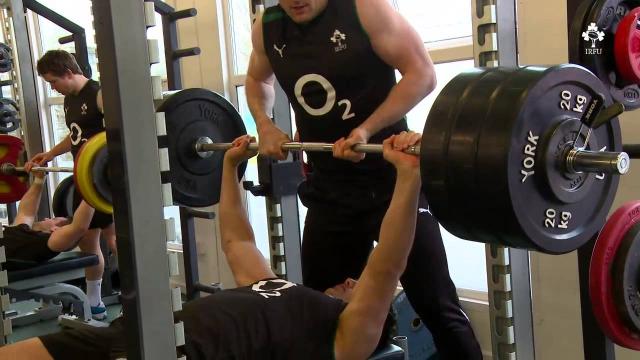
This is a great exercise for the upper body which strengthens the chest, front deltoids and triceps. It also involves a little bit of your core. You need to have a strong back to keep yourself in position throughout the movement. Like the barbell squat is the main leg exercise this is the main upper body pressing exercise. This should be performed at the start of your training. We rest at least 3 minutes between sets and lift anywhere from 1-6 repetitions.
How to preform it:
The set up:
- Start by lying back on a bench where your eyes should be right underneath the bar or slightly in front of it (meaning the bar is almost over your forehead) for a smooth unrack. Set your grip about shoulder width apart, with the further your hands being the greater chest you involve in the movement. The closer your hands are together the more your triceps are involved. Your shoulders should be “pulled back and down” into your back pocket. This pulls the shoulder joint to the back of the socket keeping it safe. We want to squeeze our trap and lat muscles at the same time to maintain this solid position.
- We want to apply some pressure into the ground with our quadriceps to involve more of the legs for a stronger press and more solid base to press from.
The movement:
- Start by taking a deep breath into your chest and stomach, squeeze the bar tightly and keep your upper back tight. Unrack the bar pause for a moment and set yourself. I like to keep a fixed gaze on the bar throughout the movement.
- Lower the weight under control, keeping your wrist and elbow joints stacked for a more safer and efficient lift. In the meantime we are increasing the pressure we are applying with our quadriceps into the ground. Like we are coiling a spring.
- Once the bar has touched your chest, pause it there slightly, apply pressure into the ground with your quadriceps and press the weight back up and away from your body. Lock out your elbows, reset your breathe and repeat.

So there you go guys, they are my favorite tips which you can use to design your own strength training program for a beginner lifter and continue to make progress long after you have surpassed the beginner stages of resistance training. If you found this article helpful in your own training please feel free to recommend it to the people in your life who could also benefit from it. The weight lifting gods will look down favorably on you! Looking forward to hearing your thoughts. Goodbye for now!

